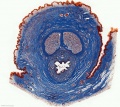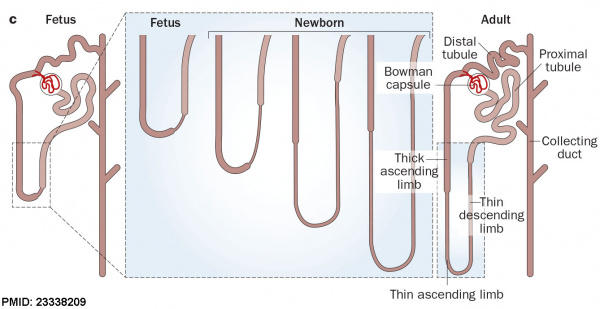Renal System - Fetal
| Embryology - 30 Apr 2024 |
|---|
| Google Translate - select your language from the list shown below (this will open a new external page) |
|
العربية | català | 中文 | 中國傳統的 | français | Deutsche | עִברִית | हिंदी | bahasa Indonesia | italiano | 日本語 | 한국어 | မြန်မာ | Pilipino | Polskie | português | ਪੰਜਾਬੀ ਦੇ | Română | русский | Español | Swahili | Svensk | ไทย | Türkçe | اردو | ייִדיש | Tiếng Việt These external translations are automated and may not be accurate. (More? About Translations) |
Introduction
Note that much of the development of the nephron occurs during the fetal period. The images below show the early fetal post-fertilization age (Week 10) (gestational age (GA Week 12) renal development. The nephron commences as a mesenchymal condensation that becomes epithelial going through a number of specific stages including later vascularization.
In humans, nephrogenesis only occurs before birth, though nephron maturation continues postnatally. Mean glomerular number shown to level at 36 weeks, increasing from about 15,000 at 15 weeks to 740,000 at 40 weeks.
Nephron development has four identifiable developmental stages:
- Vesicle (V) stage (13-19 weeks, second trimester)
- S-shaped body (S) stage ( 20-24 weeks, second trimester)
- Capillary loop (C) stage (25-29 weeks, third trimester)
- Maturation (M) stage (infants aged 1-6 months, neonatal and postnatal)
Some Recent Findings
| More recent papers |
|---|
|
This table allows an automated computer search of the external PubMed database using the listed "Search term" text link.
More? References | Discussion Page | Journal Searches | 2019 References | 2020 References Search term: Fetal Renal
|
Fetal Histology
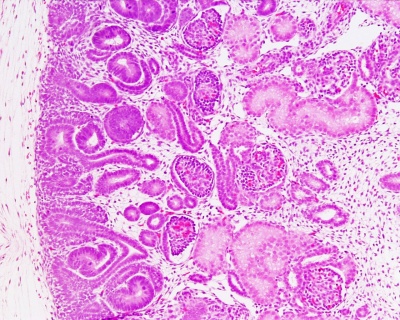
|
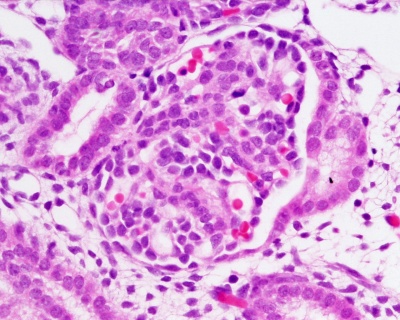
|

|
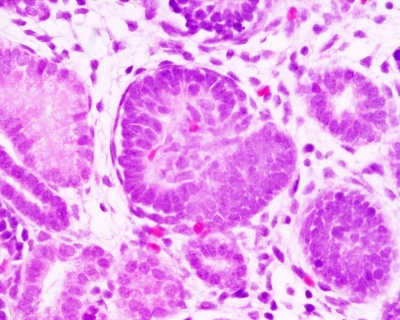
|
- Fetal Renal Links: fetal kidney histology 01 | fetal kidney histology 02 | fetal kidney histology 03 | fetal kidney histology 04
Fetal Urethra Histology
These images are a series of cross-sections through the fetal penis showing the developing urethra.
Fetal to Newborn Nephron Development
After nephron development has completed and concomitant with the development of the renal papilla in the newborn, the thin ascending limb of Henle’s loops is generated as an outgrowth from the S3 segment of the proximal tubule and from the distal tubule anlage of the nephron.[1] (birds and mammals)
| Kidney Endocrine | ||
|---|---|---|
| Hormone | Function | Comment |
| Renin | increase angiotensin-aldosterone system | paracrine, renin is released by juxtaglomerular cells |
| Prostaglandins | decrease sodium (Na+) reabsorption | paracrine, (PGE2) vasodilator regulate renal vascular reactivity |
| Erythropoietin | increase Erythrocyte production | endocrine, promotes red blood cell formation in bone marrow |
| 1,25 (OH)2 vitamin D | Calcium homeostasis | endocrine, biologically active form of vitamin D |
| Prekallikreins | increase Kinin production | paracrine, act locally to induce vasodilation and contraction of smooth muscle |
References
Online Textbooks
- Developmental Biology by Gilbert, Scott F. Sunderland (MA): Sinauer Associates, Inc.; c2000 Chapter 14 Intermediate Mesoderm | Figure 14.18. General scheme of development in the vertebrate kidney | Figure 23-23. Mechanism of mesenchymal inductive effect on the ureteric bud | Figure 14.21. Ureteric bud growth is dependent on GDNF and its receptor
- Molecular Cell Biology by Lodish, Harvey; Berk, Arnold; Zipursky, S. Lawrence; Matsudaira, Paul; Baltimore, David; Darnell, James E. New York: W. H. Freeman & Co.; c1999 Reciprocal Epithelial-Mesenchymal Interactions Regulate Kidney Development | Figure 23-21. Embryonic development of the kidney
Reviews
- Bookshelf intermediate mesoderm | kidney development | renal development | ureteric bud | nephron development | bladder development
Search PubMed
Search Pubmed: fetal kidney development | fetal renal development
Glossary Links
- Glossary: A | B | C | D | E | F | G | H | I | J | K | L | M | N | O | P | Q | R | S | T | U | V | W | X | Y | Z | Numbers | Symbols | Term Link
Cite this page: Hill, M.A. (2024, April 30) Embryology Renal System - Fetal. Retrieved from https://embryology.med.unsw.edu.au/embryology/index.php/Renal_System_-_Fetal
- © Dr Mark Hill 2024, UNSW Embryology ISBN: 978 0 7334 2609 4 - UNSW CRICOS Provider Code No. 00098G





